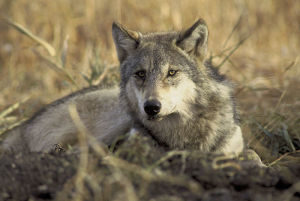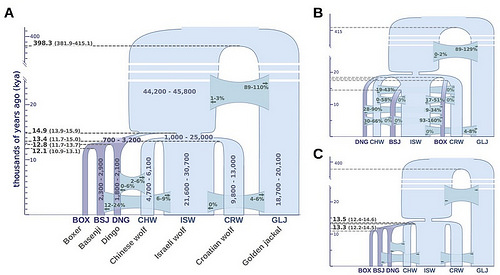
The results of a recent study of canine genomes suggests that dogs and their wolf cousins share an evolutionary history that is considerably more complex than previously thought, pointing to a common ancestor that lived between 11,000 and 34,000 years ago and that the earliest dogs may have first lived among hunter-gatherer societies, before the advent of agriculture.
It challenges the popular theory that humans domesticated dogs around the time that they developed agriculture, and that dogs evolved from a single wolf population or group.
The study, led by Adam Freedman, a postdoctoral fellow at the University of California, Los Angeles (UCLA), published in PLoS Genetics on January 16, 2014, also indicates that dogs are more closely related to each other than they are to wolves, suggesting that some of the genetic overlap observed between some modern dogs and modern wolves is more likely the result of interbreeding after dog domestication.
“Dog domestication is more complex than we originally thought,” said John Novembre, associate professor in the Department of Human Genetics at the University of Chicago and co-author of the study. “In this analysis we didn’t see clear evidence in favor of a multi-regional model, or a single origin from one of the living wolves that we sampled. It makes the field of dog domestication very intriguing going forward.”
To get to these conclusions, the research team constructed high quality genome sequences from three gray wolves: one each from China, Croatia and Israel, regions where dogs are thought to have originated. They also produced genomes from two modern dog breeds: a basenji, a breed which originates in central Africa, and a dingo from Australia, both areas that have been historically isolated from modern wolf populations. In addition to the wolves and dogs, they sequenced the genome of a golden jackal to serve as an “outgroup” representing earlier divergence.
Their analysis of the basenji and dingo genomes, plus a previously published boxer genome from Europe, showed that the dog breeds were most closely related to each other. Likewise, the three wolves from each geographic area were more closely related to each other than any of the dogs. This seems to be true regardless of geographic proximity between the dog breeds and their wolf counterparts. It suggests that, according to Novembre, both dogs and wolves were descended from an older, wolf-like ancestor common to both species. It raises the possibility that there were other, now extinct, wolf lineages from which the ancestors of the modern dogs diverged.
“So now when you ask which wolves are dogs most closely related to,” he says, “it’s none of these three because these are wolves that diverged in the recent past. It’s something more ancient that isn’t well represented by today’s wolves.”
_________________________________________________________________________________________
Graphic from the study depicting how wolf and dog lineages diverged over time. Credit: Freedma, et al / PLoS Genetics
_________________________________________________________________________________________
Accounting for gene flow between dogs and wolves after domestication was a crucial step in the analyses. According to Freedman, gene flow across canid species appears more pervasive than previously thought.
“If you don’t explicitly consider such exchanges, these admixture events get confounded with shared ancestry,” he said. “We also found evidence for genetic exchange between wolves and jackals. The picture emerging from our analyses is that these exchanges may play an important role in shaping the diversification of canid species.”
Domestication apparently occurred with significant bottlenecks in the historical population sizes of both early dogs and wolves. Freedman and his colleagues were able to infer historical sizes of dog and wolf populations by analyzing genome-wide patterns of variation, showing that dogs suffered a 16-fold reduction in population size as they diverged from wolves. Wolves also experienced a sharp drop in population size soon after their divergence from dogs, implying that diversity among both animals’ common ancestors was larger than represented by modern wolves.
The researchers also found differences across dog breeds and wolves in the number of amylase (AMY2B) genes that help digest starch. Recent studies have suggested that this gene was critical to domestication, allowing early dogs living near humans to adapt to an agricultural diet. But the research team surveyed genetic data from 12 additional dog breeds and saw that while most dog breeds had high numbers of amylase genes, those not associated with agrarian societies, like the Siberian husky and dingo, did not. They also saw evidence of this gene family in wolves, meaning that it didn’t develop exclusively in dogs after the two species diverged, and may have expanded more recently after domestication.
“We’re trying to get every thread of evidence we can to reconstruct the past,” said Novembre. “We use genetics to reconstruct the history of population sizes, relationships among populations and the gene flow that occurred. So now we have a much more detailed picture than existed before, and it’s a somewhat surprising picture.”
________________________
Robert Wayne, professor in the Department of Ecology and Evolutionary Biology at UCLA, was co-senior author of the study.
Additional authors include Rena Schweizer, Diego Ortega-Del Vecchyo, Eunjung Han, Farhad Hormozdiari, Kevin Squire and Stanley Nelson from UCLA; Ilan Gronau, Adam Boyko and Adam Siepel from Cornell Univesity; Pedro Silva from University of Porto, Portugal; Marco Galaverni from Ozzano dell’Emilia, Italy; Zhenxin Fan from Sichuan University, China; Peter Marx from Budapest University, Hungary; Belen Lorente-Galdos, Oscar Ramirez and Tomas Marques-Bonet from the Institute of Evolutionary Biology (CSIC – Universitat Pompeu Fabra), Spain; Holly Beale, Heidi Parker and Elaine Ostrander from the National Institutes of Health; Can Alkan from Bilkent University, Turkey; Carles Vila from Estacion Biologia de Doñana, Spain; Eli Geffen from Tel Aviv University, Israel; Josip Kusak from the University of Zagreb, Croatia; Clarence Lee, Vasisht Tadigotla and Timothy Harkins from Life Technologies; and Carlos Bustamante from Stanford University.
The National Science Foundation and Life Technologies provided funding and reagents.
Article Source: Adapted and edited from a University of Chicago Medical Center press release.
Cover Photo, Top Left: Gray Wolf, USFWS Endangered Species, Wikimedia Commons cc-by-2.0
_______________________________________________________________________________________________________________________
Read about the most fascinating discoveries with a premium subscription to Popular Archaeology Magazine. Find out what Popular Archaeology Magazine is all about. AND MORE:
 On the go? Purchase the mobile version of the current issue of Popular Archaeology Magazine here for only $2.99.
On the go? Purchase the mobile version of the current issue of Popular Archaeology Magazine here for only $2.99.
And, Popular Archaeology’s annual Discovery edition is a selection of the best stories published in Popular Archaeology Magazine in past issues, with an emphasis on some of the most significant, groundbreaking, or fascinating discoveries in the fields of archaeology and paleoanthropology and related fields. At least some of the articles have been updated or revised specifically for the Discovery edition. We can confidently say that there is no other single issue of an archaeology-related magazine, paper print or online, that contains as much major feature article content as this one. The latest issue, volume 2, has just been released. Go to the Discovery edition page for more information.
Subscription Price: A very affordable $5.75 for those who are not already premium subscribers of Popular Archaeology Magazine (It is FREE for premium subscribers to Popular Archaeology). Premium subscribers should email [email protected] and request the special coupon code. Or, for the e-Book version, it can be purchased for only $3.99 at Amazon.com.






